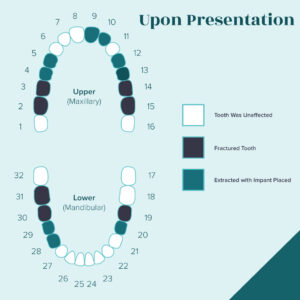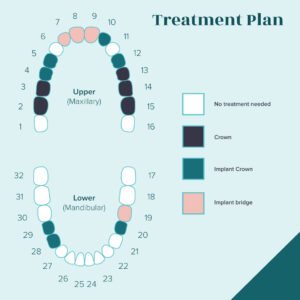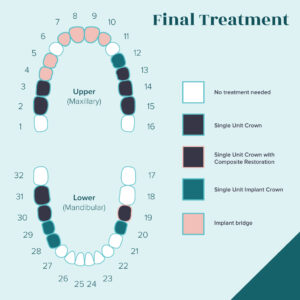Dental Trauma Case Study: Full Mouth Reconstruction After an Accident
Posted in Restorative Dentistry
A patient presented to BOCO Dental for help with oral rehabilitation after an accident. She had lost several teeth due to a fall that damaged several of her teeth. At the time of the accident, she had several extracted implants placed, and wore a temporary partial denture to replace the teeth until the implants were ready to be restored. She wasn’t happy with her smile, and didn’t understand her treatment moving forward. Being an attractive young woman, she wanted her new teeth to look and feel like the ones she had lost.
Full Mouth Reconstruction After an Accident – Where to Begin
This new patient had been living with a broken smile for over a year. The damage was severe, involving nearly every tooth in her smile zone and most of the teeth in the back of her mouth. This impacted her life in a major way. Moreover, she was not happy with the interim dental work she had received as her temporary teeth were not functioning well and she was not happy with the aesthetics.
The sooner you are able to consult with a prosthodontist after an accident, the better. A prosthodontist has the training to plan your treatment comprehensively, meaning, they will be able to strategically identify sites for implants and teeth for the best outcomes. This results in aesthetic and functional temporaries that help get you through your treatment, and a final outcome that is predictable, durable, beautiful and functional.
For this patient, the first appointment with Dr. Patt was about a year after the accident. And after she had already had teeth extracted and implants placed. Restoring the implants would have been easier had a surgical guide – with the final tooth set-up in mind – been used to place the implants. With some creativity, Dr. Patt was able to overcome these challenges and work with the existing implants. She created a treatment plan that met the functional and aesthetic needs of the patient.

HOW IS THE TREATMENT PLAN CREATED?
At BOCO Dental, all restorative cases begin with a comprehensive examination. During this appointment, Dr. Patt gets to know the patient, and collects information. Typically this involves:
- Discussing the patient’s medical and dental history
- Reviewing X-rays and other diagnostic images
- Evaluating the remaining teeth for stability
- Answering the patient’s initial questions and concerns
- And most importantly, identifying the patient’s treatment goals
This patient had specific hopes for her restoration – she wanted her smile to look the way it had before the accident. She wanted a solution that was permanent (teeth that do not come in and out), and wanted to function as she did before the accident.
FROM TEMPORARY FIXES TO A PERMANENT SOLUTION
The patient was asked to bring photos of her original smile and those images guided the patient’s tooth design. Dr. Patt spent a lot of time working with the patient on the diagnostic aspect of the case. She created physical models and wax ups to represent what the end result would look like. Using feedback from the patient, Dr. Patt adjusted the size and shape of the models. They reached an approved plan and were able to move forward with sending the models to the lab for creation.
A new temporary was made, based on her old smile and it was used to replace her current removable appliance that did not have the correct tooth position. One important aspect of the patient’s new temporary is that it was fixed to her teeth and implants, and more closely simulated what the final restoration. The patient was thrilled to have her smile back.
Expect the Unexpected
After an accident, the impact may take months for teeth to become symptomatic. It is important to monitor the teeth on a regular basis, as the nerve may die or a crack may propagate. In the particular patient’s case, she had two teeth where the nerve became necrotic (died) midway through treatment. Because of the size of the infection, a decision was made to extract both teeth and place an implant.
THE SPECIFICS: START TO FINISH.
This case was a combination fixed treatment using both natural teeth and implants. Dr. Patt used a combination of crowns, implants, bridges, single unit implants, and some composite restorations.
Upon presentation:
- Teeth 2, 3, 13, 14, 15, 19, 30, and 31 are fractured
- Teeth 4, 5, 9, 10, 12, 20, 28, 29 have been extracted with implants placed

Reviewed radiograph, wax up, treatment plan which included:
- Crowns 2, 3, 6, 7, 8 11, 13, 14, 15
- Implant crowns 4-(5), 9, 10, 12, 20, 28, 29
Patient experience pain and infection in teeth # 7, 8
- It was determined that the prognosis of these teeth was poor
- Extraction of 7, 8 and implant placement in site # 7
- Treatment plan changed to an implant bridge 7-(8)-9-19.
Preparation and temporization using provisionals from approved wax up
- Patient test drove her temporaries for 8 weeks before going to completion

Delivery of final prosthesis:
- Single unit crowns # 2, 3, 13, 14, 15, 19, 30, and 31
- Composite restoration # 19
- Single unit implant crowns # 12, 20, 28, 29
- Implant bridges # 4-(5) and 7-(8)-9-10
- Night guard
To achieve a natural look, the dentistry must match the color of the current teeth. This can be achieved by either brightening the natural teeth or tinting the implants. In this case, the patient opted for laser whitening before selecting the color of her new teeth.

It took about 6 months to achieve the final result (the treatment was delayed due to insurance issues). The patient had about 15 appointments at BOCO Dental. She was referred to a surgeon for the new implant ports. Restorations can take 1-2 months to come back finished from the lab. This gives time for the mouth to heal from the surgeries and for the preparation of the natural teeth. She was fitted for temporaries until the permanent restorations were ready.

Recovery and Follow Up After a Full Mouth Reconstruction
The patient’s recovery was smooth, considering the scope of work that she received. She experienced some tenderness and tissue irritation from the temporaries. Her bite needed slight adjustment and an occasional recement. While test driving her temporaries, we continued to assess the patient for esthetics and function.
CONCLUSION
The most significant challenge of this patient’s case was getting the aesthetics right. She was in her early 20s at the time of treatment, and very concerned with how her new teeth looked. She wanted the shade, position, and angulation of the front teeth to match exactly what she had before. Also, this patient had experienced a lot of trauma, so there was scar tissue in her mouth to work around. Dr. Patt was set on getting this perfect for her, and came close to it. Molds were made and adjusted, and a couple of pieces were sent back to the lab for changes. The BOCO Dental team worked with her at every step to achieve the aesthetic result that she wanted.
Dr. Patt has years of experience with these types of treatments. Once her patients get their teeth, they are once again happy and confident with their smiles. Dr. Patt was able to achieve a very good result, and the patient is happy, which is the goal with every patient!


